what are some benefits to binning the data
Feature Engineering Examples: Binning Numerical Features
How to employ NumPy or Pandas to quickly bin numerical features
Feature applied science focuses on using the variables already present in your dataset to create boosted features that are (hopefully) ameliorate at representing the underlying construction of your data.
For example, your model performance may benefit from binning numerical features. This essentially means dividing continuous or other numerical features into distinct groups. By applying domain knowledge, you may exist able to engineer categories and features that better emphasize important trends in your data.
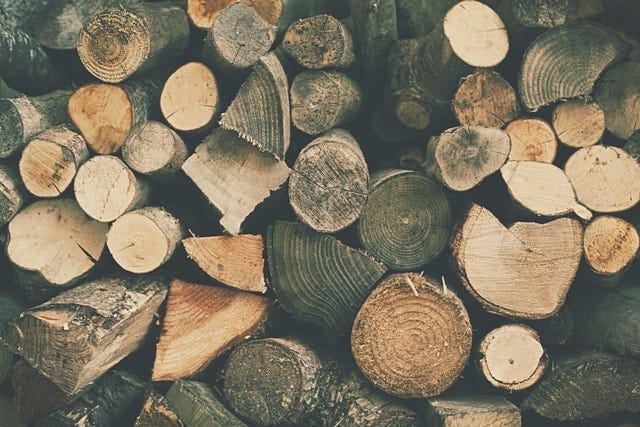
In this postal service, we'll walk through three different methods for binning numerical features with specific examples using NumPy and Pandas. Nosotros'll engineer features from a dataset with information most voter demographics and participation. I've selected 2 numerical variables to work with:
-
age: a registered voter's age at the stop of the ballot year -
birth_year: the year a registered voter was born
If y'all want to start applying these methods to your ain projects, yous'll just need to make sure you have both NumPy and Pandas installed, and so import both.
Using np.where() to Indicate Thresholds
It may be odd to remember about, but indicating whether a sure threshold is met past each example (in this case past each registered voter) is a type of binning.
For example, imagine nosotros're trying to predict whether each registered voter turned out to vote in the election. Mayhap we suspect that younger voters will be more likely to plough out if this is the first time they were eligible to vote in a presidential election. Since the legal voting age is 18, anyone less than 22 years of historic period during the current presidential election would not have been able to vote in the previous presidential election.
We tin can create an indicator variable for this threshold using np.where() which takes 3 arguments:
- a condition
- what to return if the condition is met
- what to render if the condition is not met
The following lawmaking creates a new feature, first_pres_elec, based on an individual'southward historic period:
df['first_pres_elec'] = np.where(df['age']<22, 1, 0) The condition we're checking is whether or not the individual is less than 22 years of age. If they are below that threshold, np.where() returns a 1 because this was the showtime presidential election in which they were eligible to vote. If not, then 0 is returned. From our continuous variable age, nosotros have created a new binary chiselled variable.
Perchance nosotros besides have reason to doubtable that senior citizens were more or less likely to turnout to vote. If so, we might want to draw our model'south attention to this threshold by creating some other threshold indicator:
df['senior'] = np.where(df['age']>=65, 1, 0) Now we've created two threshold indicators that divide the distribution of voter age as shown below. Younger individual's who are newly eligible to vote in a presidential election are highlighted in ruddy and seniors are highlighted in xanthous.
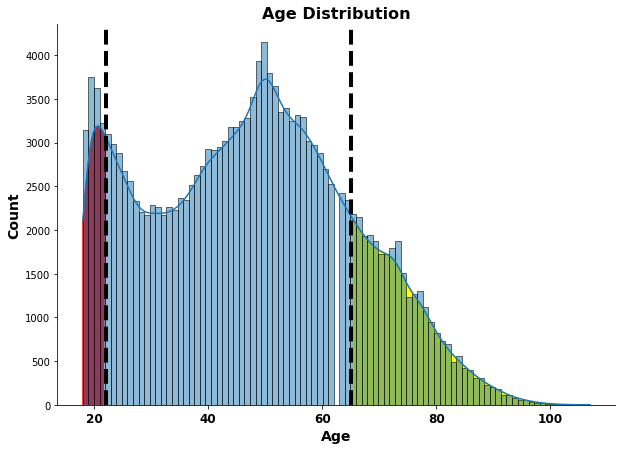
Applying a Custom Function with apply()
Information technology might make sense to divide our registered voters upwardly into generations based on their twelvemonth of birth since that oftentimes seems so wrapped up in a person'due south politics. I way to practise this is to write our ain custom role delineating the cutoffs for each generation.
Below is 1 way we could write such a custom function:
And then employ Pandas` utilise() to create a new feature based on the original birth_year variable:
Now our registered voters are broken up into 5 detached and meaningful categories. I decided to combine the 2 oldest generations (Greatest and Silent generations) so as not to create ii rare categories that each make upwardly only a very small-scale portion of the population.
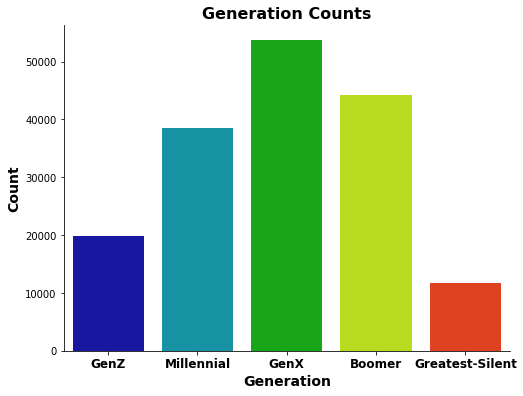
Defining Bins with pd.cut()
We can besides create the same generation bins using pd.cut() instead of writing our own office and applying it. We'll still demand to ascertain the appropriate labels for each group, also as the bin edges (cutting off birth years).
In the terminal line, we create our new feature past providing pd.cut() with the cavalcade we want binned into categories, the bins we want, and how to label each binned category.
Rather than group by generation, we could apace create a range and supply those as our bin edges. For example, if we thought it would exist meaningful to grouping age by decade, we could accomplish that with the following:
The first line defines a range that starts at x and continues up to, merely not including 110, increasing past 10 at each step. The 2d line uses that range every bit bin edges to discretize registered voters by historic period into the following groups:
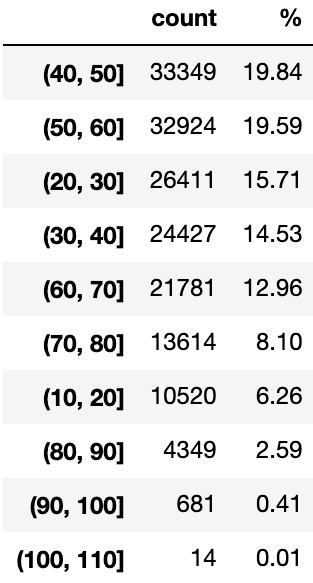
The start row shows that 33,349 or 19.84% of our voters are in their 40's. The parenthesis indicates that the 40 is inclusive, whereas the square bracket indicates the 50 is excluded from the bin. To more easily keep track of what each bin means, we could feed in the post-obit labels to pd.cut():
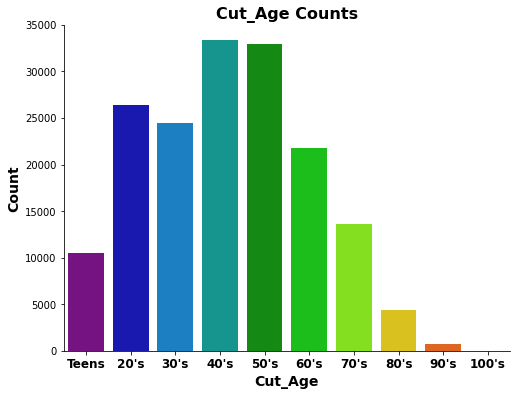
To Recap
We covered:
- What information technology ways to bin numerical features
- 1 method for creating a threshold indicator (
np.where()) - 2 methods for binning numerical features into groups (custom function with Pandas
apply()and defining bin edges withpd.cutting())
I hope you found this informative and are able to apply something y'all learned to your ain work. Thanks for reading!
Source: https://towardsdatascience.com/feature-engineering-examples-binning-numerical-features-7627149093d
0 Response to "what are some benefits to binning the data"
Post a Comment